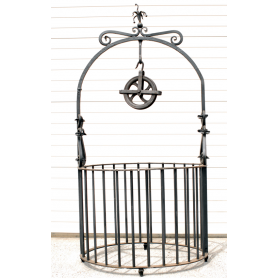No products
Prices are tax excluded
Detailed privacy of the user registry: Here
Legal notice and detailed cookies policy. By continuing to use the site, you accept our use of cookies: Find out more.
157.9
New
Nice defence or parapet solid wrought iron for the defense of surface well.
Dimensions: 234 cm high by 115 cm of diameter. Weight: 120 Kg approx.
Warning: Last items in stock!
Availability date:

Brocal de pozo en hierro forjado.
Nice defence or parapet solid wrought iron for the defense of surface well.
Dimensions: 234 cm high by 115 cm of diameter. Weight: 120 Kg approx.
Recipient :
* Required fields
or Cancel
| State | Sold as is |
It is called parapet to parapet or parapet wall a solid, for safety and utility, surrounding a well at surface level. It is usual that it will install a pulley or a cigüeño, to raise the container containing the water removed. Also is usually put up on the parapet a lid to prevent dropping dirt into the well.
From the primitive brocales masonry, ceramic or wood, to more recent work, and cement, the history of this humble and simple apron at the mouth of the wells has dressed the richest materials: marble, bronze, iron. As the younger brother of the reservoir, over the centuries, the parapet is made in terra cotta (brick), often glazed.
Etymology and metonyms
By trasnominación metonymic,identify the "pit" and "parapet"; the mind sees a well where there is only a parapet. As an experiment, pedagogical, research has shown that at the request of that 'paint a pot', both the children and many adults have drawn an edge (and when it is explained to them that what they had drawn was a curbstone, many have responded that they didn't know that word). They are words with indirect reference that allow us to understand perfectly the meaning of translation is metonymic.
In archeology, it is accepted the Latin term puteal to be called a "curbstone of the well" (in the roman house, the parapet of marble or ceramic tile that covered the hole that communicated with the tank).
The origin of the term "edge" is uncertain. For some: from Latin buccula (cheek) and bucculare (cup), which by way of the Italian primitivo would come to mean, by extension: parapet or around the mouth of the well. For others, according to Joan Corominas, it comes from the vulgar Latin brochus (broccus, pointed) and this Catalan broc (pot) following a voice celtic.
Historic iconography
Various archaeological works have documented the existence of brocales ceramic in Greece from the fifth century. C. In Spain, several museums and institutions retain puteales roman, arab, moorish and of periods most recent. Among the official institutions can be identified: Archaeological Museum of Cordoba, Museo de Santa Cruz in Toledo, Archaeological Museum of Sevilla, Museo Arqueológico Nacional (Spain), Museum of Ceramics of Barcelona. And among the private collections, of brocales arab Palace of the Countess of Lebrija.
In Toledo, in a house in the alley of San Ildefonso in which dwelt the brothers Bécquer in 1856, there was in the garden a parapet Arabic, at the foot of which was planted by the Bécquer its famous laurel. Valeriano drew, and accompanied by a text of Gustavo came to be published in The Illustration no. 4, in February 1870. Some scholars, such as Jesus Cobo, venture that the young man who appears in the drawing was Alejandra González Esteban, the lover of toledo and Gustavo Adolfo Bécquer.
The drawing of Valeriano confirms that it is the same edge exposed at the Victoria & Albert Museum in London; the parapet, which was in the Provincial Museum of Toledo, and who, having disappeared, it reappeared in the Museum of South Kensington (forerunner of the Victoria & Albert Museum). Apparently, the valuable edge went to the Provincial Museum of Toledo, at the hands of Juan Facundo Riaño, that by a little more than three pounds sterling, sold it to the collection british.
No customer reviews for the moment.